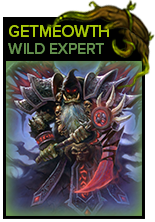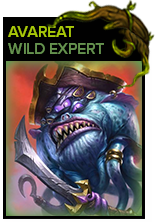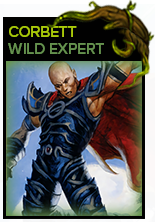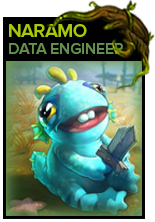
Welcome back to the Wild vS Data Reaper Report! We’re the experts from r/WildHearthstone, and we have partnered with Vicious Syndicate to create the Wild Data Reaper Report. We will be contributing the write-ups and analysis for the report, backed up by the statistics that Vicious Syndicate is famous for. The data presented in this article is based on 70,000 games since the most recent patch that included a nerf to Bloodbloom and Open the Waygate.
To ensure that we can provide updated reports more frequently, we encourage you to register to contribute your data to the Vicious Syndicate project! Signing up is quick and easy and your contributions are extremely important, and much appreciated!
Quick Links
Class/Archetype Distribution | Matchup Winrates | vS Power Rankings | Meta Score | Class Analysis & Decklists | How to Contribute | Credits
Class/Archetype Distribution
[TABS_PRO id=38675]
Much has changed since our last report. Open the Waygate and Bloodbloom have been nerfed, nerfs of 10 cards were reverted, Ashes of Outland was released, and we got an entirely new class in Demon Hunter. With everything that happened, we still see Mage and Warlock sit at the top of the play rates.
Mage accounts for around 20% of opponents at all rank brackets, with Aluneth Secret Mage being the most popular choice within the class. Both Quest Mage and Reno (Quest) Mage have dropped off in play after the nerf to Open the Waygate. Note that non-Quest Reno Mage has a very low play rate and its data is not aggregated with Reno Quest Mage.
As always, Warlock is diverse in its archetypes, but we have seen a shift in which decks are represented. Darkest Hour Warlock has disappeared, while Mecha’thun Warlock has significantly declined in play after the Bloodbloom nerf. Cube Warlock and Reno Warlock appear unscathed. After remaining a very fringe deck throughout the format’s history, Disco (Zoo) Warlock has finally emerged as a popular Wild meta deck.
While Jaina and Gul’dan remain highly prevalent, Illidan has made its impact on the format. Demon Hunter might have a fraction of the card pool available to other classes, but this hasn’t stopped it from drastically shaking up the Wild meta. The most important Wild twist on Demon Hunter is Baku the Mooneater, offering a very powerful hero power upgrade. Odd Demon Hunter appears to have become a big success, as it is the most popular deck in the format beyond Diamond 4.
Priest is a very different class these days. Reno Priest has made a big comeback thanks to Raza the Chained having its nerf reverted, and the deck is currently running rampant in the format. We expected that reverting the Raza nerf would make the deck powerful again, but its popularity might also be a testament to it being a favorite deck for many players. Big Priest maintains a presence in the format despite exhibiting a low power level ever since Barnes was nerfed.
Ashes of Outland did not have much of an effect on Paladin, with the biggest change being Murloc Paladin’s rise in play. Mech and Odd Paladin remain the same old, same old archetypes.
Warrior has seen a small renaissance, with Pirate Warrior attracting more attention after the addition of Corsair Cache (and previously, Ancharrr). Odd Warrior is also seeing more play, attempting to target the prevalence of aggressive decks in the format. Finally, there is a bit of Dead Man’s Hand Control Warrior utilizing Kargath Bladefist and Bulwark of Azzinoth.
Shaman is fractured into many different archetypes but seems to carry just one that is fully established. Even Shaman is a longstanding Wild staple and the flagbearer of the class.
Druid is a very messy class. Jade Druid is its most recognizable deck, followed by experimentation with different variants of Aviana (Combo) Druids.
Hunter does not seem to have a foothold in the format. We can identify many different archetypes being tested, but none of them have gained significant traction.
Rogue sits at rock bottom. Much like Hunter, it exhibits multiple different archetypes, but none of them has become a key player in the format.
[TABS_PRO id=38676]

[TABS_PRO id=38678]
vS Meta Score
[TABS_PRO id=38679]
Who needs six years’ worth of class sets? Demon Hunter is currently even more powerful in Wild than it is in Standard. Odd Demon Hunter is absolutely dominating the field, with an astounding win rate at all levels of play. It has efficient removal and powerful minions, but its hero power is the most important contributor to the deck’s success.
While Odd Demon Hunter is a very powerful deck with an extremely impressive matchup spread, there are a few decks in the format that seem to have an advantage against it, and most of them are arguably underplayed: Odd Paladin, Reno Priest, Pirate Warrior, and Odd Warrior.
Most of the other top-performing decks should not surprise anyone, as they have been Tier 1 performers before. Aluneth Mage has been powerful for a long time. Pirate Warrior has really upped its game thanks to Corsair Cache. Cube Warlock is a very versatile deck. Odd Paladin might cause some to lift an eyebrow, but we will note that it is the strongest counter in the format to the best deck in the game, Odd Demon Hunter.
Rounding out the elite pack is Reno Priest, which carries a very promising matchup spread. Along with a favorable matchup against Odd Demon Hunter, it performs extremely well against all the top-performing decks. Its Achilles heel is pure combo. Mecha’thun Warlock, Quest Mage, and Aviana Druid offer crippling counters, but none of these decks are top performers (yes, Quest Mage is not a top-performing Wild deck today). Therefore, Reno Priest finds itself very nicely placed in the field and will likely get stronger.
The revamped and aggressive Discard Warlock is in a competitive spot. The deck struggles into some of the elite decks in the meta, which is why we don’t expect it to be dominant in the current landscape. But, it holds its own against others and performs very well against combo decks such as Quest Mage.
Mech and Murloc Paladin sit at Tier 2. These decks are underrepresented in the current meta mostly because of better options available, with so many other aggressive decks looking highly successful. So, Paladin sits a bit out of the spotlight despite looking strong.
The balance changes have certainly affected Quest Mage, and the deck is currently exhibiting very lukewarm results, especially at the Diamond 4-1 bracket where the meta is particularly efficient and aggressive. The meta has simply become very hostile towards Quest Mage, resulting in the “aggro meta” many players reference. Quest Mage’s matchup spread is extremely polarizing. It continues to dominate slower matchups against control and other combo decks, but gets destroyed by the dominant aggressive decks. The nerf to Open the Waygate certainly impacted the deck’s ability to overcome aggression.
Tier 3 is where we find many old school decks that were perceived to be strong or are perceived to be counters to the meta. Reno Quest Mage has become much slower to complete the quest after the nerf, so while it performs better against aggressive decks than Quest Mage, it does not have the same dominant matchups into slower decks. Aggro Demon Hunter is mostly running the neutral pirate package in combination with strong class cards, but the deck is far less impressive than Odd Demon Hunter due to its inferior hero power. We also find Odd Warrior, Jade Druid, and Reno Warlock in Tier 3. Jade Druid is perceived by many as one of the best decks in the meta, but reality suggests otherwise. We can only conclude that the archetype is grossly overrated.
Class Analysis & Decklists
Demon Hunter | Druid | Hunter | Mage | Paladin | Priest | Rogue | Shaman | Warlock | Warrior
Demon Hunter has completely upended the Wild landscape. Prior to its release, many pundits were skeptical about how the class was going to compete in the format when it was years behind on expansions. The answer was simple: with enough busted cards and a busted hero power, Demon Hunter is winning.
Odd Demon Hunter is the best performing deck at every rank bracket by a significant margin. It is also the most popular deck from Diamond 4 through Legend, having a higher play rate than over half the other classes. While the core of the deck seems to have largely been figured out, the deck is undoubtedly still going through a process of refinement, being a new archetype that has already been affected by nerfs twice (and about to be hit for the third time). There are plenty of variations to the list, as players seem spoilt for choice.
However, Odd Demon Hunter is not invincible. It is slightly unfavored against both the popular Reno Priest and Pirate Warrior. It is also worth noting that it struggles badly against Odd Paladin, one of the most underplayed decks in the format relative to its performance. There are plenty of tech choices further available to players, such as Blowtorch Saboteur and cheap freeze effects, which can be highly disruptive.
Aggro Demon Hunter has not been quite the same force of nature but has performed reasonably well in its debut. Like many aggressive decks in Wild, Aggro Demon Hunter opts to employ the pirate package, built around the tempo swings and damage potential of Ship’s Cannon and Patches the Pirate. It has a tough time when facing some of the other dominant aggressive decks, such as Aluneth Mage or Odd Demon Hunter. However, it does a respectable job when given time to snowball and finish opponents off with a ton of reach.
Jade Druid hasn’t been one of the best decks in the meta over the past few weeks. Not even close. The deck does a decent job at contesting aggressive strategies such as Pirate Warrior and Aluneth Mage, but that pales in comparison to the absolute torture it goes through when playing against a variety of Quest Mages or Warlocks. It also isn’t nearly as effective as one might think against the likes of Reno Priest or Odd Demon Hunter.
Despite the hype from some sections of the player base, it does seem that most players do recognize Jade Druid for what it is, given its relatively small 2% representation on ladder at higher ranks.
Many players have continued to use lists which have cut the Oaken Summons-Vargoth package, in a bid to center the deck more around Kael’thas Sunstrider. However, this may be worth revisiting, given the nerf to Kael’thas Sunstrider and the aggressive nature of the meta.
Aviana Druid does a solid job against Reno Priest. We hope fans of the archetype savor that compliment because it’s the only one they’ll be seeing. Aviana Druid decks are highly varied, with numerous potential combo finishers. The important thing to remember is that every one of them is disastrous, folding to aggro faster than a cheap lawn chair.
Hunter has been one of the weaker classes in Wild for quite some time. While Hunter is reasonably diverse and has several archetypes bubbling at the surface, none of them have made a meaningful impact on the meta or have shown themselves to be hidden sleepers.
Hunter was one of two classes that failed to have an archetype popular enough to appear on our main tier list. We were able to get a low sample estimate on two decks, the first being Reno Hunter. Reno Hunter has been a deck on the competitive fringes since highlander support was released in Saviors of Uldum. Although there are several potential builds, Reno Hunter has typically performed best when players take a more aggressive approach to the deck (like those seen in Standard). The featured list comes from the Hé Zòng Lián Héng meta report from China.
Dragon Hunter is the other deck where we were able to get a low sample estimate, placing it in tier 3. Dragon Hunter has two potential builds. The first runs Call of the Wild, Prince Keleseth, and Spiteful Summoner and is featured in this report. The second utilizes more spells, including Corrosive Breath. Dragon Hunter has excellent mid-game pressure and tempo tools but lacks the premium early game that it would need to be a real contender in Wild.
Mage stands at the top of the play rate charts. Even though Open the Waygate was nerfed, the quest still represents over 10% of the field at legend. Coupled with Aluneth Mage being one of the most popular and dominant decks in the format, you will meet Mage on ladder once out of five games on average.
Quest Mage is a very popular deck, but the nerf to Open the Waygate made quest completion harder, giving aggressive decks more time to kill it, so we’re seeing the deck struggle against aggression. However, Quest Mage is still fast enough to maintain its strong matchups against the slower decks in Wild. The archetype offers a strong anti-control option with a very polarized matchup spread. If you’re fast enough to kill Quest Mage, they shouldn’t be an issue on your climb, but if you can’t kill them quickly enough, they will certainly be frustrating opponents to deal with.
Reno Mage copies Quest Mage’s approach to the game by using Open the Waygate as its win condition but cutting duplicates in favor of highlander cards. Removing the consistency of duplicates makes completing the quest harder, which means giving more time to the opponent to disrupt your game plan or to develop their own. This means Reno Mage loses percentage points against the slow decks compared to regular Quest Mage, but it makes up for it with better matchups against the aggressive decks on ladder. Overall, it makes Reno Mage a less polarizing deck than regular Quest Mage, but it isn’t strictly better.
Aluneth Mage is the best performing Mage deck, and one of the best performing decks in the format. The consistent, obscene mana cheating that Aluneth Mage can dish out, alongside extremely efficient anti-Aggro cards such as Flakmage and Flame Ward means the deck has a favorable to even matchup against any other aggressive deck except for Mech Paladin. Meanwhile, the deck’s burst damage fueled by its most powerful card, Aluneth, makes it very threatening for slower strategies. Only armor stacking decks and Reno Priest can beat it consistently, from this side of the meta spectrum. Indeed, Aluneth Mage is one of the best choices you could make for climbing ladder.
Odd Paladin appears to be one of the most underrated decks in Wild. Despite performing at a Tier 1 level, Odd Paladin is barely edging past a 1% play rate. Odd Paladin hasn’t received any new support or undergone any changes for some time, so this is likely why the deck does not see more widespread use. The rise of Odd Demon Hunter has been a welcome sight for Odd Paladin and a large factor for the deck’s success.
There isn’t much to report when it comes to Mech Paladin. It continues to act as an excellent foil to Aluneth Mage while getting completely worked over by Devolve and Plague of Flames. Mech Paladin has seen very few changes for some time, but recently mao221111 hit #1 legend running a list featuring the new Replicat-o-tron.
For the first time in nearly a year, Paladin has a third archetype worth talking about. Murloc Paladin was given some excellent support in Ashes of Outland and is an excellent answer to slower decks. Players have taken to trying two different approaches – with or without the Tip the Scales package. When paired with Prismatic Lens as the only other spell, Tip the Scales allows Murloc Paladins to completely flood the board in the early-mid game. However, it does come at the cost of giving up some powerful spells such as Crystology and Hand of A’dal.
Raza has been finally unchained! Reno Priest has once again established itself as one of the best decks in Wild. It handles aggressive decks and many other late-game archetypes incredibly well and exhibits one of the highest meta scores across the board. There’s just one issue that prevents it from being truly dominant and possibly the best deck in the format.
Reno Priest is crippled by the absolute fastest combo decks in the format. That’s code for Quest Mage, but also points to Mecha’Thun Warlock. These decks are downright oppressive for Reno Priest, and are some of the most one-sided matchups one will find on ladder. Just slight drops in the popularity of these decks (which aren’t exactly tearing up ladder) would see Reno Priest easily pushed even higher on the win rate charts.
Big Priest has been in the same position ever since the Barnes nerf. It sucks. What is noteworthy is it seems lower-ranked players may have finally noticed! Despite its continued struggles, Big Priest remained one of the most popular decks away from the bottleneck to legend for some time. This is no longer the case. Between Bronze and Gold, it isn’t even the most popular deck within its own class. Big Priest has been struggling for a while, but it seems players are finally, finally ready to say goodbye.
Rogue is the least popular class on ladder and joins Hunter in not having a single archetype appear in our main power rankings. But it’s not all doom and gloom.
Odd Rogue is good. Our low sample estimate places the deck at Tier 1!
We can only speculate, but Odd Rogue may simply be suffering from the player base feeling it’s redundant. The deck plays out quite similarly to Odd Demon Hunter and is going to be presenting a similar matchup spread, but Odd Demon Hunter is the absolute top performing deck in the meta and it’s a near-impossible task to outclass it. It’s also possible that the absence of new and exciting upgrades to the deck have resulted in players simply losing interest in the archetype, as we’ve seen previously from the likes of fellow Baku-Genn brethren: Odd Paladin and Even Shaman.
What isn’t speculative is that Odd Rogue is still a great choice to take to ladder, a very consistent performer, just not a flashy one. Perhaps, the nerf to Odd Demon Hunter will make players look again at the old Wild powerhouse.
Shaman is generally a big pile of mess when it comes to archetypes. Lots of experimentation and one solid, grounded deck.
Even Shaman is the only competitive archetype for the class. The Totemic Might/Surge/Splitting Axe variant has been fully adopted by the player base as the superior build. Its board flood potential has made Even Shaman faster against the slower decks in the meta. In addition, Totemic Might has become one of the most powerful cards in the deck as it’s crucial to Even Shaman’s game plan against some of the popular aggressive decks in the meta.
Reno Shaman got a few fringe tools to mess with, but none of them have really solved the deck’s inconsistency. There are many hardcore enthusiasts that still experiment with it, so we’ve provided a sample list.
Other archetypes of the class don’t see enough play for us to confidently evaluate, but none of them have given us promising signals.
Cube Warlock is a dominant force in the meta, as it’s been for quite a while now.
The deck received a great new defensive demon in Enhanced Dreadlord, and another early game removal in Unstable Felbolt. Cube Warlock is strong against most aggressive decks (save for Odd Demon Hunter), while possessing incredible threat density and swing turns against control decks. Due to the aggressive meta that we find ourselves in, many players have cut Doomguards to guarantee defensive demons off Sense Demons and Voidcaller. While this has made the deck much better against aggression, it resulted in worse matchups against slower decks such as Reno Priest and Mecha’thun Warlock. If you’re wondering why the deck struggles against Demon Hunter despite excelling against aggression, the answer is Consume Magic.
The newest addition to the Wild Warlock family is Discard Warlock. With new tools from Ashes of Outland, it has finally hit a tipping point of consistency, after four years of failures. Hand of Gul’dan has provided the deck with obscene drawing power. This draw consistency, together with a surprising amount of burst potential through Fist of Jaraxxus, Doomguard, and Soulfire have resulted in a potent aggro deck that preys on slower control and combo decks. However, holding it back are its relatively poor matchups against Demon Hunter, Aluneth Mage, Even Shaman, and Cube Warlock.
The nerf to Bloodbloom left many players thinking that Mecha’Thun Warlock would be dead in the water. However, this encouraged other players to revisit the deck and its win condition. The result was a deck that cycles faster, and utilizes Dollmaster Dorian, Plot Twist and Kael’thas/Cataclysm. While the deck is just as susceptible to aggression and Dirty Rat, it lives on for those that enjoy its combo playstyle. Mecha’thun Warlock does benefit from the decline of Quest Mage and the rise of Reno Priest.
Reno Warlock’s kit has been slightly upgraded by the additions of Unstable Felbolt, Kanrethed Ebonlocke, Keli’dan the Breaker, and Enhanced Dreadlord. However, it’s not nearly enough for Reno Warlock to perform at a high level in the current format. The deck performs particularly poorly against Mages, Demon Hunters, and other Warlocks, and those are the three most popular classes in Wild. A few good matchups against decks such as Pirate Warrior and Even Shaman are nowhere near enough to make up for it.
Warrior is starting to see the light again. The current meta has given Warrior some ways to succeed, and the class is approaching the meta with primarily two very different strategies.
On one side, we have Pirate Warrior. The new Ancharrr build cuts every single weapon except the said legendary, while still running double Corsair Cache as well as Captain Greenskin, Bloodsail Cultist and Upgrade. This means that Pirate Warrior is going to find Ancharrr early in the game and start beating your face with it while drawing two cards each turn. The cards it ends up drawing, continue to synergize with and upgrade Ancharrr.
Pirate Warrior does exceptionally well against Quest Mage and is one of the only decks in the format that exhibits a positive win rate against Odd Demon Hunter, making it one of the strongest decks in the format.
On the other side, we find Odd Warrior. This deck revolves around its Baku hero power, allowing it to soak serious punishment. Odd Warrior beats every single aggressive deck that looks to prey on Quest Mage. So, in theory, it should perform well in the current aggressive meta. However, Wild format still carries a few decks with infinite value or infinite damage potential, which naturally hard counter the removal-focused game plan of Odd Warrior. These poor matchups knock Odd Warrior down to a Tier 3 win-rate, so its success can be very inconsistent and meta dependent.
Our Data Reaper Project, including the Data Reaper Live has 3,200 active contributors. Without them, this project would not be possible, so we’d like to thank all of our contributors for their help.
Preparing our weekly article requires a significant amount of time and effort from many individuals. We would like to wholeheartedly thank our current Patreons, whose generous donations help us fund computing and server costs.
vS Gold is a new membership plan aimed to support our efforts towards improving our content and data analysis while receiving some bonuses and extra features.
Contributors
Here are all the people that participated in bringing you this edition of the [Wild] vS Data Reaper Report:

























how do you guys think the wild meta sits after todays nerfs?